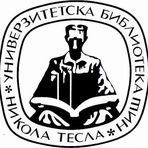Title
Poremećaji perifernog nervnog sistema kod pacijenata sa autoimunim reumatskim bolestima
Creator
Đurić, Vanja, 1976-
CONOR:
53958921
Copyright date
2024
Object Links
Select license
Autorstvo-Nekomercijalno-Bez prerade 3.0 Srbija (CC BY-NC-ND 3.0)
License description
Dozvoljavate samo preuzimanje i distribuciju dela, ako/dok se pravilno naznačava ime autora, bez ikakvih promena dela i bez prava komercijalnog korišćenja dela. Ova licenca je najstroža CC licenca. Osnovni opis Licence: http://creativecommons.org/licenses/by-nc-nd/3.0/rs/deed.sr_LATN. Sadržaj ugovora u celini: http://creativecommons.org/licenses/by-nc-nd/3.0/rs/legalcode.sr-Latn
Language
Serbian
Cobiss-ID
Theses Type
Doktorska disertacija
description
Datum odbrane: 12.12.2024.
Other responsibilities
Academic Expertise
Medicinske nauke
University
Univerzitet u Nišu
Faculty
Medicinski fakultet
Group
Katedra za neurologiju
Alternative title
Disorders of the peripheral nervous system in patients with autoimmune rheumatic diseases
Publisher
[V. N. Đurić]
Format
115, [1] list
description
Bibliografija: listovi 91-101
description
Neurology
Abstract (en)
Peripheral neuropathy (PN) is systemic connective tissue disease (SCTSs)
represents the apparent disease complications or initial manifestations of
clinically undiagnosed conditions. The aim of the study was to identify
neuropathies (Ns) and their prevalence, point out the diagnostic
significance of some electrophysiological (EP) parameters in patients with
rheumatoid arthritis (RA), systemic lupus erythematosus (SLE), and
systemic sclerosis (SSc), and establish their association with disease
activity (DA) and disease duration (DDu). A prospectiv study was
conducted at the Rheumatology Clinic of the Institute Niška Banja over a
three-year period. The study included 157 patients in , and total, of whom
61 had R, 40 had SLE, and 56 had SSc. The following parameters were
analyzed: age, gender, Ddu and DA index. Morover, clinical,
rheumatological, and neurological examinations, as well as neurology
tests, nerve conduction studies (NCS), and laboratory analyses, were also
conducted.
In the studied population, we were able to identify various forms of Ns (in
28% of patients) by NCS. In all three groups, the most prevalent type of Ns
was axonal (23,6%). There was a significant association between DA and
the occurrence of Ns (p < 0,001) in the total population. The most
important EP parameter was the sensory nerve action potential amplitude
of nervus peroneus superfitialis (65.0%) and compound muscle action
potentials amplitude of nervus peroneus (30,06%) and nervus tibialis
(28,0%). Ddu in all three groups was longer in the population of patients
with Ns. Ns are most common in patients with longer Ddu and higher
DA. The EP method is important in detecting Ns, especially in the early
detection of subclinical forms of Ns and the prevention of disease
complications.
Authors Key words
autoimunske reumatske bolesti, periferna neuropatija, sistemski
eritemski lupus, sistemska skleroza, reumatoidni artritis
Authors Key words
autoimmune rheumatic diseases, peripheral neuropathy, systemic lupus erythematosus, systemic sclerosis, rhematoid arthritis
Classification
616.833‑009.7:616‑002.77(043.3)
Subject
B 007 B640
Type
Tekst
Abstract (en)
Peripheral neuropathy (PN) is systemic connective tissue disease (SCTSs)
represents the apparent disease complications or initial manifestations of
clinically undiagnosed conditions. The aim of the study was to identify
neuropathies (Ns) and their prevalence, point out the diagnostic
significance of some electrophysiological (EP) parameters in patients with
rheumatoid arthritis (RA), systemic lupus erythematosus (SLE), and
systemic sclerosis (SSc), and establish their association with disease
activity (DA) and disease duration (DDu). A prospectiv study was
conducted at the Rheumatology Clinic of the Institute Niška Banja over a
three-year period. The study included 157 patients in , and total, of whom
61 had R, 40 had SLE, and 56 had SSc. The following parameters were
analyzed: age, gender, Ddu and DA index. Morover, clinical,
rheumatological, and neurological examinations, as well as neurology
tests, nerve conduction studies (NCS), and laboratory analyses, were also
conducted.
In the studied population, we were able to identify various forms of Ns (in
28% of patients) by NCS. In all three groups, the most prevalent type of Ns
was axonal (23,6%). There was a significant association between DA and
the occurrence of Ns (p < 0,001) in the total population. The most
important EP parameter was the sensory nerve action potential amplitude
of nervus peroneus superfitialis (65.0%) and compound muscle action
potentials amplitude of nervus peroneus (30,06%) and nervus tibialis
(28,0%). Ddu in all three groups was longer in the population of patients
with Ns. Ns are most common in patients with longer Ddu and higher
DA. The EP method is important in detecting Ns, especially in the early
detection of subclinical forms of Ns and the prevention of disease
complications.
“Data exchange” service offers individual users metadata transfer in several different formats. Citation formats are offered for transfers in texts as for the transfer into internet pages. Citation formats include permanent links that guarantee access to cited sources. For use are commonly structured metadata schemes : Dublin Core xml and ETUB-MS xml, local adaptation of international ETD-MS scheme intended for use in academic documents.


